The Great Flood of 1927 unleashed a spring season of catastrophic events along the banks of the Mississippi River. A weather system that stalled over the Midwestern states in the fall of 1926 brought untold amounts of water to the Upper Mississippi River region. The region’s burgeoning tributaries caused the Mississippi River to overflow in eleven states from Illinois to Louisiana.
That same system brought heavy rainfall to the Yazoo-Mississippi Delta, an alluvial plain located in northwest Mississippi. In early April 1927, Henry Waring Ball of Greenville, Mississippi, wrote in his diary:
“April 8, 1927…at 12 it commenced to rain hard and I have seldom seen a more incessant and heavy downpour until the present moment – 9 p.m. I have observed that when the river is high it is always raining. The water is now at the top of the levee, and we have heavy showers and torrential downpours almost everyday and night. The air is saturated with moisture, and the luxuriance of plant growth is extraordinary. Nell went through pouring rain to the garden club.
“15 The worst Good Friday I ever saw. A night of incessant storms, wind, lightning, thunder and torrents of rain. Raining constantly all this morning, none of us slept much. A day too dark and stormy to go to church or even out of doors. Discomfort. Flowers and plants beaten to the earth, little half-drowned chickens in baskets in the kitchen, house leaking in many places. Everybody in a bad humor except Jane, the cook. River appallingly high, and levees in very precarious condition. Too dark to write, another big storm coming – noon.
“16 Yesterday and last night were somewhat memorable. It rained in torrents and almost without intermission for nearly 48 hours. More than 10 inches fell. A 12-inch fall is reported for Cairo. ...”
The levee breaks
The western edge of the Mississippi Delta is outlined by the Mississippi River along with its companion, a man-made levee, or earthen dam, that protects the valuable farmland from river overflow. The steady rainfall filled streams, bayous, creeks, and ditches in the Delta region and saturated the farmland. As the water rose in the Mississippi River and levees broke in other states, all indications were that 1927 would be one of the worst years for flooding.
Levee guards were placed in camps at strained sites along the top of the levee and ordered to maintain them from danger of crevasse, a break in the levee which would allow water to enter the area it protected. As the water rose on the levee, it was the levee guard’s duty to fill sandbags and place them on top of the levee in order to stay ahead of the water height.
In Mississippi there were two levee areas of special concern. Both were north of Greenville at the Miller Bend and the Mound Landing levees. A break at either of these places would allow water into the Delta town with the county’s largest population of about 15,000 people. Levee guards were on duty and the stack of sandbags were almost even with the rising water when the levee at Mound Landing in lower Bolivar County gave way on the morning of April 21, 1927.
The alarm that the levee had broken was given to the people of Greenville by a prearranged signal, the fire whistle. Many of the town’s citizens were experienced from previous floods and had prepared their homes and businesses by pulling up carpets and placing furniture and goods on raised platforms above the water that would enter their homes. Those who were less experienced immediately began fleeing the area by train and continued to do so until the tracks became unusable. The highest areas of Greenville were covered by only a few feet of water, however, the lower areas were inundated from eight feet to over rooftops.
The crevasse was so huge it allowed a volume of raging water that covered nearly one million acres with water ten feet deep in ten days. The water, higher and stronger than any previous flood, soon engulfed a large portion of the Mississippi Delta, covering some two million acres of land in its final reach. It would be a continuing flood of water — the Mississippi River flowed through the crevasse for months.
Lucy Somerville [Howorth] tells in her diary how citizens of Greenville, in anticipation of a crevasse prepared their town and homes for the flood. She wrote, “There was a low protection levee north of town. The east and south were protected, or so most people believed, by a railroad embankment. The people as a whole were confident the town would not get any water even should the levee break. For weeks the river rose, it passed the highest stage ever known before, 52.3/10 feet reached in 1922 , and went up steadily, a foot a day, which, as well as the height, was unprecedented.” To read a full account of the flood by Lucy Somerville, click here.
As the people of Greenville watched the river rise they waited for the fire alarm. Mayor of Greenville John Aloysius Cannon’s notes show the confusion among the people as the event happened on April 21, 1927. “We were somewhat late in turning on the alarm, as we could get no one at the Levee Board with the proper authority to say where the break was.”
Sixteen-year-old Mildred Shepherd was studying for her Latin exam when she heard the fire alarm. “Kid that I was, I yelled when I heard the fire whistle, ‘Hotdog! Now, I don’t have to take that Latin Exam.’ And I threw my book into the air hitting the porch ceiling . . . Adding to the excitement was a man on horseback going pell-mell down the street yelling, ‘Go to the levee! Go to the levee! The levee has broken.’”
Tent city
A refugee camp was established on the levee at the end of Washington Avenue in Greenville. Until the American Red Cross arrived, families, mostly African-Americans, slept in makeshift tents of quilts and materials brought along in their escape from their homes. When it arrived, the Red Cross passed out tents, saw that kitchens and sanitary facilities were built, and organized the large camp which would grow north along the levee for seven miles. Typhoid shots and other immunizations were given to prevent the spread of disease. Greenville’s William Alexander Percy, son of LeRoy Percy, headed the Relief Committee in Greenville. Local officials called in the National Guard to keep order.
With a sea of water in the commercial and residential areas of downtown Greenville, the town resembled Venice, Italy, with its canals. Citizens either rowed down the streets and avenues or walked on the raised walkways that were built in front of the commercial areas. The newspaper continued to operate, banks did business, and telephones and electricity remained turned on. Steamboats carried many of the white wives and young children away to Vicksburg or Memphis.
African-American families were instructed by some community leaders to stay on the levee to work in flood control and, later, recovery efforts. The men feared that if they allowed this labor force to leave they might not return. This decision to not let African-Americans evacuate and to work them without pay would soon bring an eruption of racial tensions.
Greenville’s protection levee north of town did not hold in the initial April flood. Mayor Cannon and several leaders decided to stop the continuing flow of water into Greenville and to prevent the common occurrence of a June rise, the second assault of water, from entering the town. William Beanland, a civil engineer, was chosen to handle the repair work. He immediately went to work on plans to build a mud box with driven pilings and sandbags to seal the gaps. He, with the help of a committee of African-American leaders, got about five hundred Black men working two shifts around the clock for nine days to repair the protection levee.
The laborers were not paid and resented being threatened that if they did not participate in the levee repair, or other work such as unloading the food sent on barges by the Red Cross, that they would not be allowed to have the food that the Red Cross was handing out. Thus, the people struggling to live on a sliver of ground above water, became aggravated about their circumstances. Their squalid living conditions and work requirements were first reported through the Associated Negro Press and by the end of May had spread to the White press.
As word spread about the mistreatment of Black people in the levee camps, Secretary of Commerce Herbert Hoover, who served as chairman of a special committee to coordinate all flood relief efforts, created the Colored Advisory Committee to look into the allegations and named Robert Moton from the Tuskegee Institute to head it. After investigations, the committee presented a harsh report to Hoover, but he failed to take any action. As a result of the living conditions caused by the flood, Black citizens were compelled to leave Washington County, of which Greenville was the county seat, to seek better lives in the North.
Meanwhile, conditions improved in Greenville once the protection levee was finished. It prevented a second wave of rising water in June and with the aid of large pumps the town was drained. A special celebratory parade was held July 4, 1927. The floodwaters, however, would still cover the greater portion of the Delta for many more months.
The Mississippi River Flood of 1927 was the nation’s greatest natural disaster. The National Safety Council estimated deaths in the Yazoo- Mississippi Delta alone at 1,000. In Mississippi it directly affected an estimated population of 185,495. A total of 41,673 homes were flooded; 21,836 buildings were destroyed; 62,089 buildings were damaged; and 2,836 work animals, 6,873 cattle, 31,740 hogs, and 266,786 poultry were drowned. An entire crop year was lost.
A major result of the 1927 flood, which had an impact in eleven states, was the National Flood Control Act of 1928 passed by the U. S. Congress.
A closing glimpse
The teenager Mildred Shepherd, whose father was an auditor for Mississippi Power & Light Company in Greenville, remained with her family at home throughout the flood with water at the top of their doorsteps. She writes about life after the waters left and gives a glimpse of her everyday life.
“As the waters receded people drifted back to their homes to clean up and continue their lives where they left off. One day after the waters had dropped to a depth of about a foot, Teddy (who was three years old) wanted to wade using Daddy’s knee boots. Mama stood on the steps and agreed to let him wade on the front walk. She cautioned Ted to be careful and he said, ‘I am, Mama. I’m holding to my pants.’
“The flood took its toll on the trees and shrubs. Aunt Ruby lost her fruit and nut trees, purple plums, peaches and apples along with an English walnut tree which was an oddity of this particular section of the country.
“It was the mode of the times for yards to be outlined by carefully clipped privet hedges. Our side of the street featured a hedge beginning at MP&L Co. corner and continuing to the corner of Clay and included Uncle Clarence’s and Aunt Ruby’s property. Popa Ed Lenz’s hedges was clipped to form an arch over the walk way to his front door. Mocking birds often nested in the arch. The flood killed the hedges and they had to be removed.”
Princella Wilkerson Nowell lives in Greenville, Mississippi, and teaches Spanish at Washington School.
Readers may wish to read a previous Mississippi History Now article on the Mississippi River: "Making the Mississippi Over Again: The Development of River Control in Mississippi," by Greg O'Brien.
Lesson Plan
-

Downtown Greenville, Mississippi, on April 30, 1927, six days after the levee break. Courtesy Mississippi Department of Archives and History, accession no.: PI/1992.0002.020 -
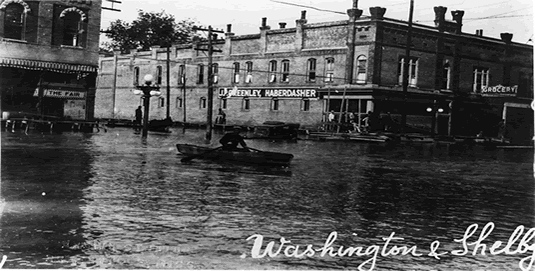
Intersection of Washington and Shelby streets in downtown Greenville. Note elevated boardwalks. Courtesy Mississippi Department of Archives and History, accession no.: PI/CI/G74.4, no. 57
-
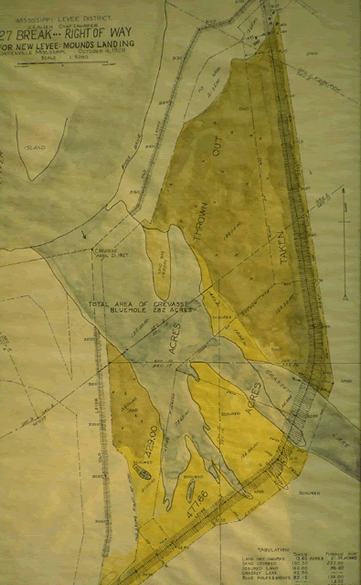
The enormous size of the crevasse at Mound Landing is shown in this 1928 map prepared by the Mississippi Levee District. Photograph of map by Princella W. Nowell. -
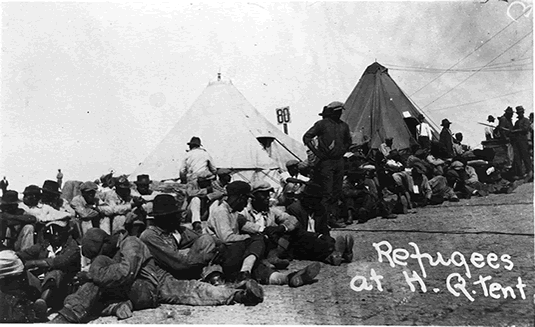
Flood refugees on the levee in Greenville. Courtesy Mississippi Department of Archives and History, accession no.: PI/CI/G74.4, no. 46 -

Flood refugees in Yazoo City, Mississippi, on May 13, 1927. Courtesy Mississippi Department of Archives and History, accession no.: PI/ 1992.0002.103 -
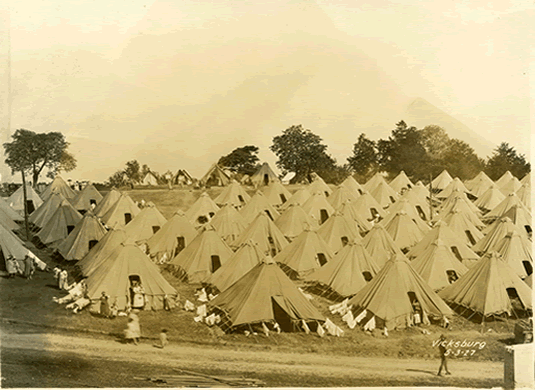
Flood refugees evacuated to “tent city” on the hills of Vicksburg, Mississippi. Courtesy Mississippi Department of Archives and History, accession no.: PI/1992.0002.071 -
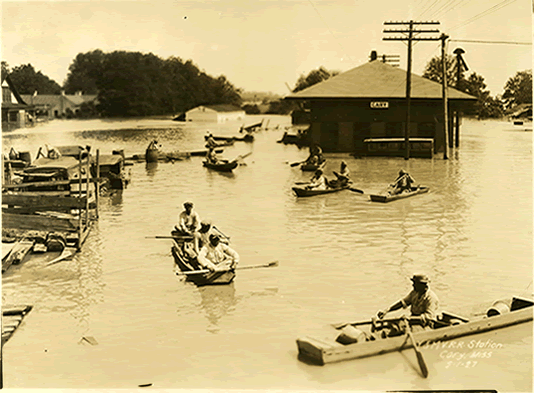
People get around in boats at the railroad station in Cary, Mississippi, on May 1, 1927, ten days after the flood. Courtesy Mississippi Department of Archives and History, accession no.: PI/ 1992.0002.039 -
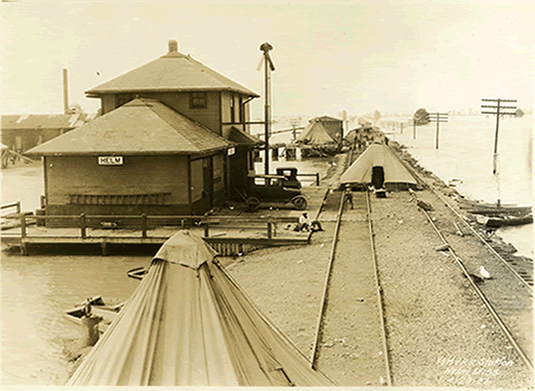
The Yazoo & Mississippi Valley Railroad Station in Helm, Mississippi, on April 29, 1927. Courtesy Mississippi Department of Archives and History, accession no.: PI/1992.0002.007
Sources and suggested reading:
Books:
Barry, John M. Rising Tide: The Great Mississippi Flood of 1927 And How It Changed America. New York: Simon & Schuster, 1998.
McCain, William D. “The Triumph of Democracy 1916-1932” in A History of Mississippi, Volume Two, edited by Richard Aubrey McLemore. Jackson: University Press of Mississippi, 1973.
Percy, William Alexander. Lanterns on the Levee. New York: Knopf, 1941.
Documents:
Henry Waring Ball Diary, Mississippi Department of Archives and History Mildred Shepherd [Rushing] Diary, Shepherd-Baird family history book written by Mildred Shepherd Rushing. Unpublished. Used by permission of Dr. Ted Shepherd.
Lucy Somerville [Howorth], “The Mississippi Flood of 1927” published in June 1927 edition of Women’s Press. The Lucy Somerville Howorth Collection, Delta State University Archives, Cleveland, Mississippi.
